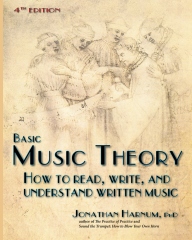Basic Music Theory encompasses more than just the basics for beginning piano or violin students. Anyone who hopes to play any instrument should find this a great starting place since author Jonathan Harnum draws on his experience of having taught thousands of students.
Basic Music Theory is just loaded with information, yet manages to convey that information with a light touch and a bit of humor that makes it understandable for teens and adults, and maybe even for middle school students.
Chapters are generally short, and each chapter is followed by “Study Guide” questions that review key points in the lesson. “Practical Use Exercises” following the questions might require writing musical notation on staves, tapping out the student’s own musical composition, experimenting with an instrument (if available), and other creative ways of learning. Chapters are grouped into “Parts” with cumulative reviews at the end of each Part. Answers to both Study Guide and cumulative review questions are visible to the right of the questions. Students might want to use a piece of paper to cover the answers to avoid temptation before they provide their own answers.
The book seems to assume ready access to various types of instruments such as a drum set, guitar, and piano keyboard. While that would be very helpful, it isn’t essential for all of the lessons. On the other hand, students should be tackling at least one instrument while learning music theory. But that could be a string, percussion, or wind instrument; piano; or even voice. I imagine a student could skip “Chapter 23: The Guitar Fingerboard” if he is learning to play the piano or vice versa with “Chapter 20: The Piano Keyboard,” but it sure is helpful to have a broader knowledge of music for more than one instrument.
Basic Music Theory covers theory essentials: the staff, notes, rests, time and beats, meter, dotted notes, triplets, clefs, accidentals, major and minor scales, key signatures, intervals, modes, triads, chord extensions, chord inversions, and chord progressions. It even gets into the “blues scale,” double-dotted notes, double flats, and odd meters.
In keeping with the goal to encompass music for various instruments, topics are addressed more comprehensively than in books dedicated to a single instrument. For example, in the section on clefs, we learn about treble and bass clefs as well as C clefs and rhythm clefs.
The book takes an occasional break from music theory lessons with “interludes” on related topics such as practicing, conducting, and musical terms. The interludes add information, but they don’t conclude with questions. For example, the interlude on practice goes beyond the general admonition to practice every day to discuss motivation, the concept of talent, selecting the most effective time to practice, the structure of a practice session, and practical practice strategies.
The book includes occasional QR codes and web links to additional content online where you can see, hear, or read more on a topic. Basic Music Theory is available in print or digital editions. The digital edition has active links that you might find convenient. With the print book, you can scan the QR codes or type in the URLs to bring up the extra content.
While Basic Music Theory is great for beginners, they might need to progress through it slowly. It’s probably best if they have opportunity to work with what they are learning rather than quickly trying to master all of the theory. Those who already have some knowledge of music theory can breeze through the early chapters, perhaps still picking up some concepts or information they missed in earlier studies. They can quickly move on to the more challenging chapters.
Harnum’s love of music and his desire to share his enthusiasm makes Basic Music Theory much more appealing than the dry music theory books of my own personal experience.











